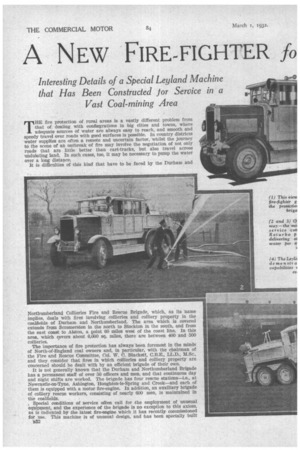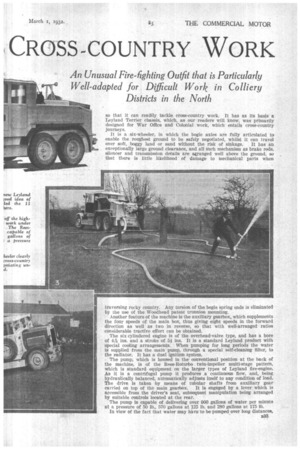A NEW FIRE-FIGHTER Jo
Page 50

Page 51

Page 52

If you've noticed an error in this article please click here to report it so we can fix it.
CR SS-COUNTRY WORK
THE fire protection of rural areas is a vastly different problem from that of dealing with conflagrations in big cities and towns, where adequate sources of water are always easy to reach, and smooth and speedy travel over roads with good surfaces is possible. In country districts water supplies are often a remote and uncertain factor, whilst the journey to the scene of an outbreak of fire may involve the negotiation of not only roads that are little better than cart-tracks, but also travel across undulating land. In such cases, too, it may be necessary to pump the water over a long distance.
It is difficulties of this kind that have to be faced by the Durham and Northumberland Collieries Fire and Rescue Brigade, which, as its name implies, deals with fires involving collieries and colliery property in the coalfields of Durham and Northumberland. The area which is covered extends from Scremerston in the north to Stockton in the south, and from the east coast to Alston, a point GO miles west of the coast line. In this area, which covers about 6,000 sq. miles, there are between 400 and 500 collieries.
The importance of fire protection has always been foremost in the minds of North-of-England coal owners and, in particular, with the chairman of the Fire and Rescue Committee, Col. W. C. Blackeht, C.B.E., LL.D., M.Sc., and they consider that fires in which collieries and colliery property are concerned should be dealt with by an efficient brigade of their own.
It is not generally known that the Durham and Northumberland Brigade has a permanent staff of over 50 officers and men, and that continuous day and night shifts are worked. The brigade has four rescue stations—i.e., at Newcastle-on-Tyne, Ashington, Houghton-le-Spring and Crook—and each of them is equipped with a motor fire-engine. In addition, an auxiliary brigade of colliery rescue workers, consisting of nearly 600 men, is maintained in the coalfields.
, Special conditions of service often call for the employment of unusual equipment, and the experience of the brigade is no exception to this axiom, as is indicated by the latest fire-engine which it has recently commissioned for use. This machine is of unusual design, and iias been specially built so that it can readily tackle cross-country work. It has as its basis a Leyland Terrier chassis, which, as our readers will know, was primarily designed for War Office and Colonial work, which entails cross-country journeys.
It is a six-wheeler, in which the bogie axles are fully articulated to enable the roughest ground to be safely negotiated, whilst it can travel over soft, boggy land or sand without the risk of sinkage. It has an exceptionally large ground clearance, and all such mechanism as brake rods, silencer and transmission details are arranged well above the ground, so that there is little likelihood of damage to mechanical parts when • traversing rocky country. Any torsion of the bogie spring ends is eliminated by the use of the Woodhead patent trunnion mounting.
Another feature of the machine is the auxiliary gearbox,, which supplements the four speeds of the main box, thus giving eight speeds in the forward direction as well as two in reverse, so that with well-arranged ratios considerable tractive effort can be obtained.
The six cylindered engine is of the overhead-valve type, and has a bore of 4T9e ins, and a stroke of 51 ins. It is a standard Leyland product with special cooling arrangements. When pumping for long periods the water is supplied from the main pump, through a special self-cleaning filter, to the radiator. It has a dual ignition system. The pump, which is housed in the conventional position at the back of the machine, is of the Rees-Roturbo twin-impeller multi-stage pattern, which is standard equipment on the larger types of Leyland fire-engine.
• As it is a centrifugal pump it produces a continuous flow, and, being hydraulically balanced, automatically adjusts itself to any condition of load. The drive is taken by means of tubular shafts from auxiliary gear • carried on top of the main gearbox. It is engaged by a lever which is accessible from the driver's seat, subsequent manipulation being arranged by suitable controls located at the rear.
The pump is capable of delivering over, 000 gallons of water per minute 'at a pressure of 50 lb., 570 gallons at 125 lb. and 280 gallons at 175 lb.
In view Of the fact that water may have to be -pumped over long distances, B33
two 3-in, delivery valves are used in place of the more orthodox 2i-in. deliveries, so as to avoid heavy frictional losses.
During the past few years there has been •a decided tendency to provide better protection from the elements for the men engaged in tire-fighting operations, and in the design of the body of the new machine this point has received close attention. The body layout is unusual, and is the result of experience gained by the chief officer of the brigade, Mr. Frederick P. Mills, P.S.I., M.E.FireE.
The rear portion follows standard practice and provides accommodation for 500 yds. of 3-in. hose and a similar quantity of 2i-in. hose, in addition to the usual first-aid apparatus, stand pipes and branches. Other important equipment includes a searchlight outfit and a new half-hour type of rescue apparatus, made by Siebe, Gorman and Co., Ltd., to enable the firemen to enter poison-laden atmospheres. The forward part of the vehicle, however, as will be seen from the illustrations, is really a double cab, which gives comfortable accommodation for a personnel of 11. Behind the driver's cab is a compartment which is similar to a railway carriage in that it provides accommodation for eight men to sit facing each other. In the specification is included a 35-ft. ladder, this being carried on brackets fixed to the top of the cab and to the rear part of the body.
• The machine is to replace a unit that has been in service for 22 years, and which was one of the first motor fire-engines to be used in this country.
Amongst the many fires that the brigade has dealt with in recent years are those in connection with colliery headgears, screening plant, by-product plants, rows of colliery houses, etc., and, apart from being able to give protection in these directions, the new outfit can, in case of fire, be employed for pumping water down a mine.




































































































